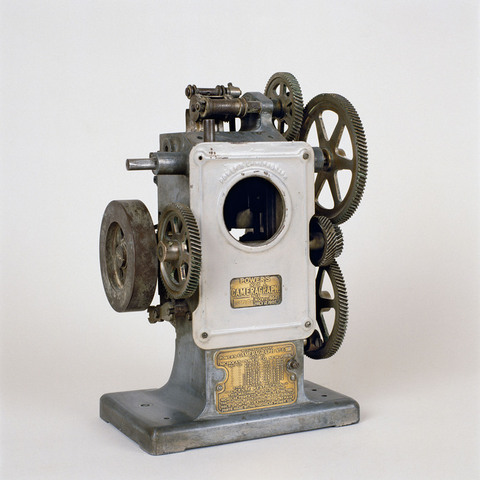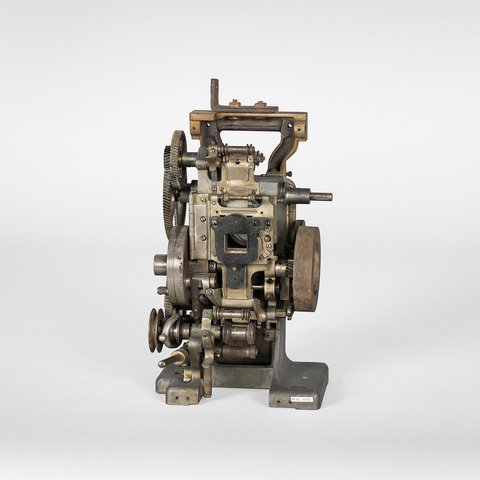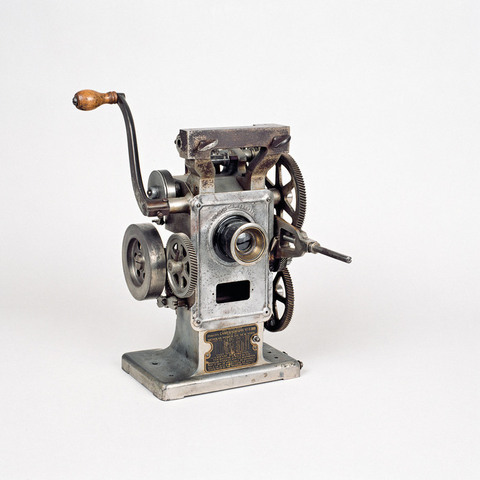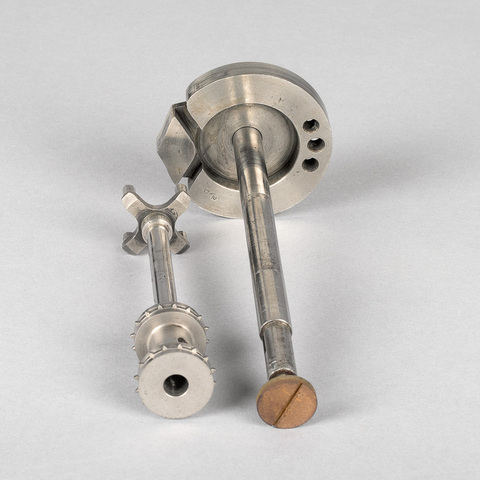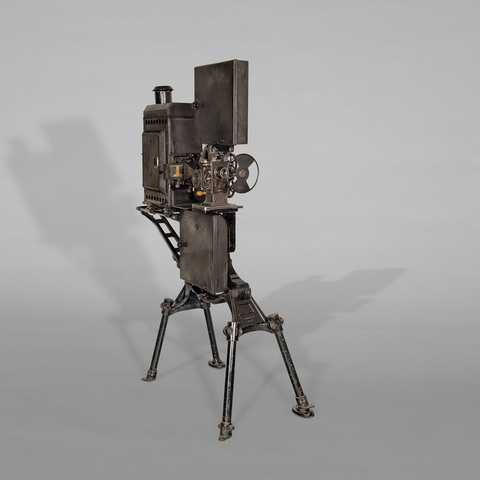Projecteur de film 35 mm
Fiche détaillée
Type de l'appareil
entraînement du film 35 mm par croisillon à quatre bras portant à chaque extrémité un goujon s'engrénant dans une came en forme de losange ; deux débiteurs dentés ; couloir presseur
Auteurs
Informations non disponibles
Fabricants
Nicholas Power Company
New York, New York, 90 Gold Street
Utilisateurs
Informations non disponibles
Distributeurs
Nicholas Power Company
New York, New York, 90 Gold Street
Sujet du modèle
Informations non disponibles
Objectif
absent
Taille de l'objet
Ouvert :
Informations non disponibles
Fermé :
Longueur : 28 cm
Largeur : 19.5 cm
Hauteur : 31.5 cm
Diamètre :
Informations non disponibles
Taille de la boîte de transport
Informations non disponibles
Remarques
Deux étiquettes en laiton : "Power's N° 6 A. Cameragraph Pat's N° 27 198. Nov. 1, 1904, July 17, 1906" et "Reg. Trade Mark. Power's Cameragraph N° 6 A. Made by Nicholas Power Co. New York Pat N° 773 981. Nov 1, 1904 - N° 818 047. Apr. 17, 1906 - N° 826 112. July, 1, 1906 - N° 959 601. May, 31, 1910 - N° 1 041 813. Oct. 22, 1912 - N° 1 051 632. Janu. 28, 1913 - N° 1 088 364. Feb. 24, 1914 - N° 1 129 121. Feb. 23, 1915 - N° 1 184 126. May 23, 1916. Others patents pending. License restriction. This machine is sold by the Nicholas Power Co. with the restriction that it may be used only as originally sold or with substitute or repair parts made by the Nicholas Power Co."
"Seul le Power est silencieux. Supprime la croix de Malte. Ses avantages : mouvement intermittent, régulateur de boucle automatique, fixité absolue. Durée double des meilleurs et meilleur marché. Adopté par les grands cinémas à Paris : salle Marivaux, ciné Max Linder, etc. Renseignements, prix, notice, démonstration : la Community (S.A.F.), 33 rue de Surène, VIIIe" (Tout Cinéma, Paris, 1925, p. 770 ; idem, 1927, p. 874).
"Le mécanisme qui communique un mouvement intermittent est constitué de deux pièces. La première comprend une came dont la forme est approximativement celle d'un losange et la seconde est formée par un croisillon avec quatre bras perpendiculaires portant chacun, à leur extrémité externe, un goujon. [...] Lorsque l'appareil fonctionne, la came tourne à une vitesse comprise entre 800 et 1200 tours par minute, la came et l'axe qui la porte sont massifs de manière à être rigides et à offrir de la résistance à l'usure. [...] L'invention est relative aux appareils pour la projection de vues animées et notamment au mécanisme destiné à communiquer un mouvement intermittent au film, ce mécanisme comportant un organe mené qui est fixé sur l'axe rotatif actionnant le film et porte plusieurs goujons équidistants ; un organe menant, rotatif, ayant une came disposée approximativement en losange et de manière à passer entre les goujons de l'organe mené à chaque rotation de l'organe menant" (Société Nicholas Power, brevet français n° 422 572, déposé le 15 novembre 1910, "Perfectionnements aux appareils pour la projection de vues animées").
"The Nicholas Power Company presents the Power's Cameragraph which has justly been styled by the moving picture public as "the modern motion picture machine". The models now offered to the public are N° 5 and 6. The former has been a favorite with exhibitors, operators and patrons of moving picture theatres since 1906 and its continued popularity in all parts of the North American Continent have led to continuance of its manufacture, notwithstanding the recent appearance of the later model N° 6, which has been designed especially to meet the most recent conditions which have arisen in the art of projecting motion pictures. Power's Cameragraph N° 6 complete equipment, approved by the New York Board of Fire Underwriters and the Department of Water Supply, Gas and Electricity : Cameragraph mechanism n° 6 ; Upper film magazine ; Lower film magazine with patented takeup attachment ; Table board with leg flanges ; Set of 4 telescoping tubular legs nickel plated ; Set of 2 braces for rear legs and spreader for the front legs ; Lamphouse complete with mica lined top and slinding ways ; "Perfect" electric arc lamp ; Adjustable lamp shoe and post with rack adjustment ; Russia iron cone and adjustable slide carrier frame ; Double slide carrier and condensers complete with two lenses and separate steel lens holders ; First quality motion picture objective lens ; First quality stereopticon objective lens with adjustable stereopticon attachment ; Double knife switch with slate base, Russia iron switch cover ; Set of abestos covered wire connections for lamp and rheostat, with solderless terminals ; Enclosed rheostat for 104 volts alternating curent or 110 volts direct current ; Style B automatic fire shutter upper and lower film shields ; Two of 10 inch reels ; Improved film rewinder ; price complete as listed : $ 225.00. Power's Cameragraph n° 6 is a worthy successor to the N° 5 Cameragraph which for four years past has been accepted as the highest standard of moving picture machine construction. For more than two years our experimental department has been constantly at work endeavoring to produce a moving picture machine free from all the defects which have been present in greater or less degree in the moving picture machines which have been offererd to the public. [...] Other important objects sought in the manufacture of the new Cameragraph have been the elimination of the disagreeable flicker from the pictures, the projection of perfectly steady pictures, the provision of every possible device to insure absolute safety in handling inflammable celluloid films and the arrangement of film feeding devices that will prevent wear on the film. [...] The intermittent movement of the N° 6 Cameragraph is the most radical departure from previous pratice which has recently been made in construction of moving picture machines. It has no pinwheel, no star wheel or "Geneva". It is not a beater, or dog movement, nor is it a claw movement. Neither is it a frictional gripper. It is practically noiseless in operation ; it will last indefinitely without perceptible wear. It moves the film with the least possible strain, and the picture projected is charaterized by perfect steadiness. Only two parts are embodied in the intermittent movement. The driving element of this movement is a revolving cam of hardened tool steel which is of diamond shape and is formed integral with a heavy steel disc rigidly secured to the main spindle or shaft of the mechanism. A locking ring for the driven element is also formed on the face of the disc in such relation to the cam that the driven element passes without noise from engagement with the cam into engagement with the locking ring. The driven element is a cross which is rigidly mounted on the end of the intermittent spindle and is provided with a heavy pin on the face of each arm for engagement with the cam. The cross and the pins are cut from a single block of tool steel so that the pins cannot possibly loosen and be forced out of proper relation to the cam. The parts of the intermittent movement are enclosed in an oil-tight casing with an oil feed cup and by keeping the casing properly supplied with oil a practically noiseless operation of the movement without perceptible wear on the parts is insured. With this novel type of intermittent movement more rapid travel of the film is produced but with less strain on the perforations than with other types" (Power's Cameragraph, The Perfect Moving Picture Machine, 1910 Catalog, New York, Nicholas Power Company, 1910).
"The N° 5 has been a favorite with exhibitors, operators and patrons of moving picture theatres since 1906. Its continued popularity in North and South America, Europe and Australia, has determined a continuance of its manufacture, notwithstanding the appareance of the later models N° 6 and 6A, designed especially to meet more exacting conditions brought about by sharp competition in the art of projecting motion pictures. The manufacture of n° 5 will be discontinued after May 1st, 1913" (Power's Cameragraph, The Perfect Moving Picture Machine, 1913 Catalog, New York, Nicholas Power Company, 1913).
"From the beginning Nicholas Power began to build up a strong patent wall around his developments, being the first to invent (1904) a satisfactory device for centering the picture in the while the projector was operating the picture in the aperture while the projector was operating, thus obviating the need for shutting down the equipment and showing a slide very common in those days : "One minute, please, to frame picture". Two years later Power obtained two other valuable patents covering the takeup device, or method of "rolling a film on lower reel without tearing the film during the operation", and the basic patent covering upper and lower film magazines having fire-prevention film valves. These three patents were the basis for the subsequent sucess of Nicholas Power and his successor, Nicholas Power Co., a corporation formed in 1907. Between 1904 and 1922, Nicholas Power obtained 57 patents covering the design and construction of important improvements in Power's projectors N° 4, 5, 6, 6A, the latter being the last one manufactured. These patents covered many important devices, among which were means for : 1) Preventing the breaking of film between the intermittent movement and take-up sprocket. 2) An automatic fire shutter interposed between the film and the illuminant. 3) Further developments and improvements in film magazines and fire-prevention means therefor. The latter three patents, along with many others, were issued prior to 1914 and apply to the Powers N° 4 and 5 projectors. About 1909 a very important development took place in projector construction - the introduction of the Powers N° 6 Cameragraph which embodied a fundamentally new principle of intermittent movement whereby the film was moved down from frame to frame successively for projection, the period of movement being obscured from the screen, and one picture at a time being exposed to the illuminant ; the exposure and cut-off were brought about by a revolving shutter synchronized with the intermittent and this synchronism being maintained regardless of the framing position of the intermittent assembly. This new movement was very much faster in its pull-down period than anything previously attempted, thus allowing a longer exposure to the screen and, therefore, greater illumination. It was this improvement which forced other early competitors from the market. While theorically pratical, the first model of this new-type movement was not altogether successfull, due to mechanical difficulties ; but it was quickly replaced with a device of similar construction which constituted the movement of the most recent and wholly successful Powers projector. The Powers 6A projector was marketed in 1911, this being an all-metal equipment including stand, lamphouse, magazines and the N° 6 mechanism, thus eliminating the flimsy wooden tableboard. The 6A enjoyed tremendous success for many years, the period 1912 to 1916 witnessing many major projector advances of which the following are especially noteworthy : A new stand or pedestal with a new takeup device and means for making what had by this time become necessary adjustments ; a new and sturdier lamphouse to handle the increasing demands for higher currents for illuminants ; motor-driving means, the fire authorities having then begun to allow the use of such drives ; a combination of fire-prevention devices ; a mechanical variable-speed control and motor assembly ; film tension shoes for projector gates whereby the film was held accurately in the focal place for proper screen focus of the image ; an improved method of framing the image ; a lamphouse unit for use with the highly efficient incandescent lamps developed about that time, and a findamentally new principle in automatic speed-controlling mechanism for use with projector drive motors. Many other patents were issued to Nicholas Power Co., including a great number covering a complete motion picture projector embodying numerous basic ideas and improvements. This new projector was to be known as the Powers N° 7 ; but it was never put into production. The year 1911 saw only two active projector manufacturers ; but beyond the horizon was brewing a storm of formidable proportions, the first faint clouds of which were barely visible. The Simplex projector was on the way. In 1909 two new organisations had entered the field : the Precision Machine Co., which took over the inventions of Francis B. Cannock which were represented by the Edengraph, forerunner of the Simplex Projector ; and the American Motion Picture Machine Co., which developed the Standard projector. The latter company failed in 1913, however, leaving but three surviving projector manufacturers : Nicholas Power, Precision Machine Co., and Enterprise Optical Co. The Precision group lost no time in giving strenuous and persistent battle to Nicholas Power, and after only three years of intensive competition the Simplex projector was firmly established on the market. Thus was established the basis for the famous Power-Simplex feud, with the proponents of each projector proving ready literally at the dropping of a word to vociferously, and often militantly, defend the projector of their choice. The Simplex projector was of entirely different design from the Powers in that is was a considerably more compact mechanism completely enclosed, being on a pedestal of entirely new design and having a great many features which appealed tremendously to the projectionnist. Precision also built up an excellent patent structure covering, among many others, the following salient features : 1) The basic patent covering the entire equipment and including the new framing device by means of which this operation was accomplished by rotating the intermittent casing about the intermittent sprocket axis. 2) A new method of focusing lenses on projectors. 3) An entirely new gate and film-holding structure to maintain the film in the correct optical plane above the intermittent sprocket. 4) Complete enclosures for the mechanism, all prior mechanisms being of the open type with gears exposed. 5) The method of framing the picture in the Simplex mechanism. 6) An improved film-gate door lock, enabling the projectionist to easily close and latch the film-enclosing gate. 7) An entirely new design of fire valve for film magazines. 8) An entirely new type of mechanically-controlled variable-speed device for use with constant speed motors on projectors. The corporate existence of International Projector Corp. dates from 1925 as a result of the merging of Precision Machine Co., Nicholas Power Co., and the Acme Motion Picture Projector Co., with all manufacturing facilities and personnel being concentrated at 90 Gold Street, New York City. This consolidation ushered in a new era of development in projector manufacture, one of the early fruits of which was the Super Simplex mechanism. This projector, while resembling to some extent the older regular Simplex mechanism, embodied many improvements making for better visual projection, greater ease of operation, and considerably more efficient handling of the lens system. A great improvement was made in the intermittent movement by the development at the plant of machinery for manufacturing the operating parts of the movement, that is, the star wheel and cam, and for obtaining far greater accuracies than were obtainable previously. Another major Super Simplex development was the removal of the revolving cut-off shutter to the rear of the projector so that is interposed between the illuminant and the aperture plate. Other Super Simplex improvements involved a new type pad roller arm for accuretely maintaining the film on the sprockets, a threading lamp for quick and accurate framing before projection, and an assembly of enclosures for the entire mechanism. [...] The Regular Simplex mechanism which first appeared as a single-bearing unit and then gave way to the double-bearing alignment. The Super Simple into the manufacture of which was introduced to the trade the practice of hardened-and-ground sprockets. This unit also featured the rear shutter mechanism. The Simplex E17 which included a double shutter and a one-shot oiling system which embraced all moving elements except the intermittent movement. The Simplex E7 which included a double shutter and radical advances as to constitute probably the most important milestone in projector manufacture. On the sound reproduction front, Simplex brought out in 1938 the famous Simplex 4-Star sound system which was the first to utilize permanent magnet speakers. This was followed in 1950 by the radically new design of X-L loudspeakers for use in both enclosed and open-air theatres. In 1954, Simplex scored another notable advance when it made available to the sorely pressed motion picture industry a 4-track magnetic sound reproducer system" (Edward B. Garrison, "Evolution of the Simplex Projector", International projectionist, July 1954, p. 30-44.)
"The Powers N° 6 Cameragraph reached the market during 1909. This very ruggedly built projector was destined to become one of the most successful for many years to come. It was the first to revive the front revolving shutter which was used almost exclusively thereafter, until about 1930, on all projectors. It introduced adjustable tension springs in the gate. However, the intermittent movement was the greatest innovation in ths newest Powers projector. A five-to-one pin cross movement of entirely new design was used. It gave longer exposure without imposing strain on the film or the mechanism. Many old timer, today, still wonder why this movement hasn't been revived in some modern projector. Instead of a pivoted idler roller on the top sprocket, there were two small rollers at a fixed distance from the sprocket, similar to the design of many 16 mm projectors today. A shoe was used on the lower sprocket, instead of a roller. The pin cross movement was mounted inside the flywheel. A short time after the first of these machines was used in theaters, and after many complaints from users, the Powers Company announced that, due to the fact that the industry was changing over to the complete use of noninflammable film, several elements in the design were found to be impractical and would be changed at no cost to the purchaser. The changes consisted of replacing the upper and lower idlers with the type formerly used, as well as enclosing the intermittent in an oil-tight casing. But it was to be more than 40 years before the industry would finally adopt noninflammable film" (Don G. Malkames, "Early projector mechanisms", Journal of the SMPTE, october 1957, vol. 66)
Bibliographie
Power's Cameragraph, The Perfect Moving Picture Machine, 1910 Catalog, New York, Nicholas Power Company, 1910.
Power's Cameragraph, The Perfect Moving Picture Machine, 1913 Catalog, New York, Nicholas Power Company, 1913.
Reel and slide magazine trader announcements, vol. 1, n° 9, novembre 1918.
Tout Cinéma, Paris, 1925, p. 770 ; idem, 1927, p. 874.
Walturdaw Knowledge, The House of Cinema, London, Walturdaw, 1930.
Edward B. Garrison, "Evolution of the Simplex Projector", International projectionist, July 1954, p. 30-44.
Don G. Malkames, "Early projector mechanisms", Journal of the SMPTE, october 1957, vol. 66.
